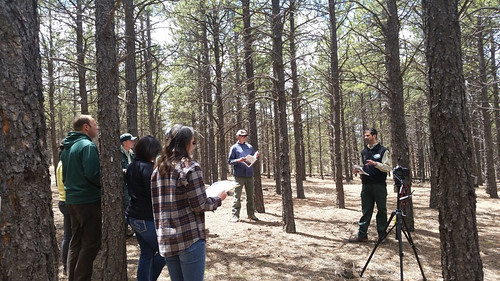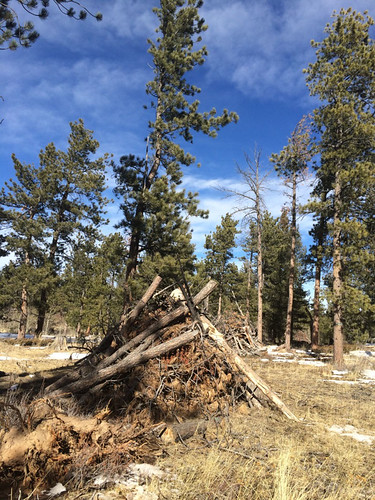
Research Forester Mike Battaglia leads a field tour at the Manitou Experimental Forest, in Colorado, describing research aimed at understanding how different tree densities influence growth rates and subsequent re-entry, in order to maintain longevity of restoration treatments. Photo credit: US Forest Service
On June 9, 2012, a lightning strike sparked a wildfire in the mountains west of Fort Collins, Colorado, burning into the Roosevelt National Forest. The High Park fire burned over 87,000 acres and remains the third largest fire in recorded Colorado history, with more than 250 homes destroyed.
Matt Champa, assistant prescribed fire specialist with the Canyon Lakes Ranger District of the Arapaho and Roosevelt National Forests, remembers clearly the two and a half weeks the High Park Fire burned. Matt was among the individuals actively working on the ground to suppress and contain the fire; at its height, more than 2,000 people were involved in the suppression effort.
Although Matt serves as a firefighter when needed during fire season, he and his team work year-round to restore fire-adapted ecosystems and to help reduce the risk of extreme wildfires in the future. Prescribed fire, or controlled burns, is the careful planning and application of fire to promote healthy forests, for instance reducing the amount of hazardous fuels and encouraging the growth of native plant species. These activities recognize the important ecological role of wildfire in these ecosystems.
But when you’re faced with over 650,000 acres of national forest land, as Matt is with the Canyon Lakes Ranger District, how do you decide which areas should be treated? I had the opportunity to shadow Matt as he surveyed fuel treatment projects on the Roosevelt National Forest and gained insight into this work. The main takeaway, Matt emphasized, is that this is a team effort. A suite of specialists, including geospatial planners, wildlife biologists, hydrologists, and timber professionals, work together to identify sites for treatment in a process that is strongly grounded in science. Perhaps most importantly, this work is done collaboratively with local communities through a public scoping process. To maximize effectiveness, the team tries to focus its efforts where communities are doing complementary work.
It is also important to recognize the long timescale of these projects – fully completing a fuel treatment takes an average of ten years from start to finish. Although this seems long in terms of human time scales, it is quite short for these ponderosa and lodgepole forests, where trees can grow for hundreds of years.
Scientists with Forest Service Research & Development support land managers like Matt by conducting cutting-edge research to help make fire and fuel management more effective, safe and ecologically appropriate. At the Rocky Mountain Research Station, scientists use case studies, field research and simulation models to better understand fire regimes and the ecological impacts of management activities and to develop management techniques that incorporate the patterns and processes that result from natural disturbances.
For example, Research Forester Mike Battaglia and other collaborators work directly with Forest Service land managers to address questions and concerns about ponderosa pine restoration on the Colorado Front Range, which is part of the Collaborative Forest Landscape Restoration Program (CFRLP). Their research is helping provide land managers with guidelines for their restoration work.
“In the early stages of fuels reduction management in ponderosa pine forests, there was an urgency to reduce forest density without considering how the trees were spatially distributed within the stand and on the landscape,” said Battaglia. “However, we now know that much of our ponderosa pine forests consisted of small tree groups, with small and large openings, and individual trees distributed across the stand.”
Using sophisticated fire behavior models, they are investigating how these complex forests historically burned to determine structures that will meet fuel hazard reduction objectives while maintaining forest structures that provide other ecological benefits. Information from these studies is intended to inform future management activities.
Matt has worked for over a decade in this area, and his connection to and knowledge of the land run deep. Matt inspired me with the passion he has for his work and his dedication to the communities that he serves. The highlight of our day together was when he showed me where a completed fuel treatment curbed the spread of the High Park Fire along the edge of the Cache la Poudre Wilderness. The difference that an effective fuel treatment project can make is clearly demonstrated here; where one side of the site is comprised of charred tree remains and the other of healthy trees.
This post is part of a series featuring the Forest Service’s work on restoration across the country.

A pile of hazardous fuels, prepared for burning. Photo credit: US Forest Service
No comments:
Post a Comment
Note: Only a member of this blog may post a comment.